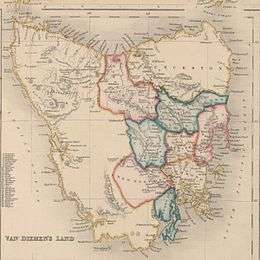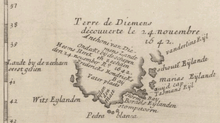Van Diemen's Land
Van Diemen's Land was the original name used by most Europeans for the island of Tasmania, part of Australia. The name was changed from Van Diemen's Land to Tasmania in 1856.
Van Diemen's Land | |||||||||
|---|---|---|---|---|---|---|---|---|---|
| 1825–1856 | |||||||||
 | |||||||||
.jpg) 1828 map | |||||||||
| Capital | Hobart | ||||||||
| Demonym(s) | Van Diemonian usually spelt Vandemonian | ||||||||
| Government | Self-governing colony | ||||||||
| Monarch | |||||||||
• 1825–1830 | George IV | ||||||||
• 1830–1837 | William IV | ||||||||
• 1837–1856 | Victoria | ||||||||
| Lieutenant-Governor | |||||||||
• 1825–1836 | Sir George Arthur first | ||||||||
• 1855–1856 | Henry Young last | ||||||||
| History | |||||||||
• independence from the Colony of New South Wales | 3 December 1825 | ||||||||
• Name changed to Tasmania and self-rule | 1856 | ||||||||
| |||||||||
| Today part of | |||||||||
 1852 map of Van Diemen's Land | |
| Geography | |
|---|---|
| Location | Southern Ocean |
| Coordinates | 42°00′S 147°00′E |
| Area | 68,401 km2 (26,410 sq mi) |
| Highest elevation | 1,614 m (5,295 ft) |
| Highest point | Mount Ossa |
| Administration | |
Australia | |
| Largest settlement | Hobart Town |
| Demographics | |
| Population | 40,000 (1855) |
| Pop. density | 0.59/km2 (1.53/sq mi) |
| Ethnic groups | European Australians, Aboriginal Tasmanians |
History
Exploration
The Dutch explorer Abel Tasman was the first European to land on the shores of Tasmania in 1642. Landing at Blackman Bay and later having the Dutch flag flown at North Bay, Tasman named the island Anthoonij van Diemenslandt in honour of Anthony van Diemen, Governor-General of the Dutch East Indies, who had sent Tasman on his voyage of discovery. Between 1772 and 1798, only the southeastern portion of the island was visited. Tasmania was not known to be an island until Jacob Craig and George Bass circumnavigated it in Norfolk in 1798–1799.
Around 1784–1785, Henri Peyroux de la Coudrenière, an army officer serving in Spanish Louisiana, wrote a "memoir on the advantages to be gained for the Spanish crown by the settlement of Van Dieman's Land".[1] After receiving no response from the Spanish government, Peyroux proposed it to the French government, as "Mémoire sur les avantages qui résulteraient d'une colonie puissante à la terre de Diémen".[2]
In January 1793, a French expedition under the command of Antoine Bruni d'Entrecasteaux anchored in Recherche Bay and a period of five weeks was spent in that area, carrying out explorations into both natural history and geography. In 1802 and 1803, the French expedition commanded by Nicolas Baudin explored D'Entrecasteaux Channel and Maria Island and carried out charting of Bass Strait. Baudin had been associated, like Peyroux, with the resettlement of the Acadians from French Canada – mostly from what is now called the New Brunswick–Nova Scotia area to Louisiana.
Early colonisation

Sealers and whalers based themselves on Tasmania's islands from 1798 and in August 1803, New South Wales Governor Philip King sent Lieutenant John Bowen to establish a small military outpost on the eastern shore of the Derwent River to forestall any claims to the island arising from the activities of the French explorers.
From 24 September 1804 until 4 February 1813 Van Diemen's Land was split into two administrative divisions, Cornwall County in the north and Buckingham County in the south. The border between the counties was defined as the 42nd parallel (now between Trial Harbour and Friendly Beaches). Cornwall County was governed by William Paterson while Buckingham County was governed by David Collins.[3][4]
Major-General Ralph Darling was appointed Governor of New South Wales in 1825, and in the same year he visited Hobart Town, and on 3 December proclaimed the establishment of the independent colony, of which he became governor for three days.[5]
The demonym for Van Diemen's Land was "Van Diemonian", though contemporaries used the spelling "Vandemonian".[6]
In 1856, the colony was granted responsible self-government with its representative parliament, and the name of the island and colony was officially changed to Tasmania on 1 January 1856.[7][8]
Penal colony
From the 1800s to the 1853 abolition of penal transportation (known simply as "transportation"), Van Diemen's Land was the primary penal colony in Australia. Following the suspension of transportation to New South Wales, all transported convicts were sent to Van Diemen's Land. In total, some 73,000 convicts were transported to Van Diemen's Land or about 40% of all convicts sent to Australia.[9]
Male convicts served their sentences as assigned labour to free settlers or in gangs assigned to public works. Only the most difficult convicts (mostly re-offenders) were sent to the Tasman Peninsula prison known as Port Arthur. Female convicts were assigned as servants in free settler households or sent to a female factory (women's workhouse prison). There were five female factories in Van Diemen's Land.
Convicts completing their sentences or earning their ticket-of-leave often promptly left Van Diemen's Land. Many settled in the new free colony of Victoria, to the dismay of the free settlers in towns such as Melbourne.
On 6 August 1829, the brig Cyprus, a government-owned vessel used to transport goods, people, and convicts, set sail from Hobart Town for Macquarie Harbour Penal Station on a routine voyage carrying supplies and convicts. While the ship was becalmed in Recherche Bay, convicts allowed on deck attacked their guards and took control of the brig. The mutineers marooned officers, soldiers, and convicts who did not join the mutiny without supplies. The convicts then sailed the Cyprus to Canton, China, where they scuttled her and claimed to be castaways from another vessel. On the way, Cyprus visited Japan during the height of the period of severe Japanese restrictions on the entry of foreigners, the first Australian ship to do so.
Tensions sometimes ran high between the settlers and the "Vandemonians" as they were termed, particularly during the Victorian gold rush when a flood of settlers from Van Diemen's Land rushed to the Victorian goldfields.
Complaints from Victorians about recently released convicts from Van Diemen's Land re-offending in Victoria was one of the contributing reasons for the eventual abolition of transportation to Van Diemen's Land in 1853.[10]
Name
Anthony Trollope used the term Vandemonian: "They are (the Vandemonians) united in their declaration that the cessation of the coming of convicts has been their ruin."[11]
In 1856, Van Diemen's Land was renamed Tasmania. This removed the unsavoury criminal connotations with the name Van Diemen's Land (and the "demon" connotation) while honouring Abel Tasman, the first European to find the island. The last penal settlement in Tasmania at Port Arthur closed in 1877.[12]
Popular culture
Film
- The 2011 Australian drama film The Hunter stars Willem Dafoe, Sam Neill and Frances O'Connor.[4] In the film, a shadowy corporation ("Red Leaf") sends a mercenary Martin David (Dafoe) to Tasmania to track down a thylacine, a supposedly extinct animal whose genetic code holds the secret to a dangerous weapon.
- The 2008 film The Last Confession of Alexander Pearce tells the true story of Alexander Pearce through his final confession to fellow Irishman and colonial priest Philip Conolly. The film was nominated for a Rose d'Or, an Irish Film and Television Award, an Australian Film Institute Award and won an IF Award in 2009.
- The 2009 film Van Diemen's Land follows the story of the infamous Irish convict, Alexander Pearce, and his escape with seven other convicts.
- The 2013 ABC telemovie The Outlaw Michael Howe is set in Van Diemen's Land and tells the story of bushranger Michael Howe's convict-led rebellion.
- The 2018 film Black '47 directed by Lance Daly and set in the 1847 period of the Irish Potato Famine depicts a particularly harsh judgement imposed on an Irish farmer for a minor theft by a British Judge in Connemara, which includes six months hard labor, then transport to the Penal Colony in Van Diemen's Land.
- The 2018 film The Nightingale is set in 1825 during the Black War and depicts the revenge taken by an Irish female convict for the murder of her family by British soldiers.
Music
- U2's 1988 album Rattle and Hum has a song called "Van Diemen's Land" written by The Edge with lead vocals also by The Edge.
- Tom Russell sets Van Diemen's Land as the ship's destination in his song "Isaac Lewis" on the album "Modern Art".
- In the traditional Irish folk song "The Black Velvet Band", the protagonist is found guilty of stealing a watch and is sent to Van Diemen's Land as punishment.
- The song "Van Diemen's Land" in the album titled "Parcel of Rogues" with vocals by Barbara Dickson is about an Irish man caught for poaching and transported to Van Diemen's Land and the hardships he has living there.
- Russell Morris released an album titled "Van Diemen's Land" in Australia in 2014. The title track describes the voyage of a convict being transported to Van Diemen's Land and was released with a video shot in Tasmania.
- The Roud Folk Song Index includes two different English transportation ballads with the title Van Diemen's Land, both about a poacher sentenced to transportation to the penal colony.
Literature
Australian winner of the Nobel Prize for Literature Patrick White's novel A Fringe of Leaves places much of the novel's beginnings in Van Diemen's Land.
- Van Diemen's Land is the setting for Richard Flanagan's novel Wanting (2008).
- Van Diemen's Land is the setting of Gould's Book of Fish: A Novel in Twelve Fish by Richard Flanagan (published 2002), which tells the story of a man who is transported to the island, and runs afoul of the local (and rather insane) authorities.
- Brendan Whiting's book Victims of Tyranny, gives an account of the lives of the Irish rebels, the Fitzgerald convict brothers who were sent to help open up the north of Van Diemen's Land in 1805, under the leadership of the explorer Colonel William Paterson.
- In Cormac McCarthy's novel Blood Meridian, one of the characters in the Glanton Gang of scalpers in 1850s Mexico is a "Vandiemenlander" named Bathcat. Born in Wales he later went to Australia to hunt aborigines, and eventually came to Mexico, where he uses those skills on the Apaches.
- From The Potato Factory by Bryce Courtenay (1995), "... subtracting till my fingers dropped; into Van Diemen's Land." This is a quote from Emily Dickinson's Poem "If You Were Coming in the Fall". Two of the main characters in Cortenay's novel are transported Van Diemen's Land as convicts and another travels there, where around half of the novel takes place.
- In the novel The Convicts by Iain Lawrence, young Tom Tin is sent to Van Diemen's Land on charges of murder.
- In the novel The Terror by Dan Simmons (2007). In this novel about the ill-fated exploration by HMS Erebus and HMS Terror to discover the Northwest Passage. The ships left England in May 1846 and were never heard from again, although since then much has been discovered about the fate of the 129 officers and crew. References are made to Van Diemen's Land during the chapters devoted to Francis Crozier.
- Van Diemen's Land is the setting of the novel English Passengers by Matthew Kneale (2000), which tells the story of three eccentric Englishmen who in 1857 set sail for the island in search of the Garden of Eden. The story runs parallel with the narrative of a young Tasmanian who tells the struggle of the indigenous population and the desperate battle against the invading British colonists.
- Christopher Koch's novel Out of Ireland describes life as a convict in Van Diemen's Land.
- Richard Butler's novel The Men That God Forgot (1977) is based on the historical events of ten convicts who escaped from Van Diemen's Land to Valdivia, Chile in 1833.
- Marcus Clarke used historical events as the basis for his fictional For the Term of his Natural Life (1870), the story of a gentleman, falsely convicted of murder, who is transported to Van Diemen's Land.
- Julian Stockwin's nautical fiction series, The Kydd Series, includes the book Command (2006) in which Thomas Kydd takes a ship to Van Diemen's Land, at the behest of then governor of New South Wales, Philip Gidley King, for the purpose of preventing French explorers from establishing a French settlement on the island.
- Kevin G. Dyer's novel Dark Night in Van Diemen's Land tells the story of a young couple transported to the Port Arthur penal settlement.
- J.W. Clennett's 2015 graphic novel, The Diemenois, is set during an alternate history in which Napoleon Bonaparte fakes his death and flees to West Van Diemen, an area of Tasmania colonised by France. The story takes place in the fictional city of Baudin (where modern-day Stanley is located), named after French cartographer Nicolas Baudin.
See also
- Cape Grim massacre
- Cyprus mutiny
- Colony of Tasmania
- Governors of Tasmania
- Van Diemen's Land Company
- Apostolic Vicariate of New Holland and Van Diemen's Land (Catholic missionary jurisdiction)
Notes
- Liljegren, E. R. (1939). "Jacobinism in Spanish Louisiana, 1792–1797". Louisiana Historical Quarterly. 22 (1): 47–97. ISSN 0095-5949.
- Paul Roussier, "Un projet de colonie française dans le Pacifique à la fin du XVIII siecle", La Revue du Pacifique, Année 6, No.1, 15 Janvier 1927, pp.726–733.; Robert J. King, "Henri Peyroux de la Coudrenière and his plan for a colony in Van Diemen's Land", Map Matters, Issue 31, June 2017, pp.2–6.
- "Constitutional Events". Tasmanian Parliamentary Library. Retrieved 11 June 2019.
- "Colonel Collins' Commission 14 January 1803 (NSW)". Museum of Australian Democracy. Retrieved 11 June 2019.
- "150th Anniversary of Australia". The Mercury. Hobart, Tasmania. 26 January 1938. p. 6. Retrieved 26 January 2012 – via National Library of Australia.
- "Vandemonian – definition of Vandemonian by the Free Online Dictionary, Thesaurus and Encyclopedia". Thefreedictionary.com. Retrieved 7 February 2013.
- Newman, Terry Becoming Tasmania. Companion Web Site (Parliament of Tasmania)
- VanDiemensLand.com. About Van Diemen's Land
- Maxwell-Stewart, Hamish. "The state, convicts and longitudinal analysis." Australian Historical Studies 47, no. 3 (2016): 414-429.
- Fletcher, B. H. (1994). 1770–1850. In S. Bambrick (Ed.), The Cambridge encyclopedia of Australia (pp. 86–94). Cambridge: Cambridge University Press.
- quoted by Patsy Adam Smith p.248 of Smith, Patsy Adam and Woodberry, Joan (1977) Historic Tasmania Sketchbook Rigby ISBN 0-7270-0286-4
- Australian Government, National Heritage site. Port Arthur Historic Site
References
- Alexandra, Rieck (editor) (2005) The Companion to Tasmanian History Centre for Tasmanian Historical Studies, University of Tasmania, Hobart. ISBN 1-86295-223-X.
- Boyce, James (2008), Van Diemen's Land. Black Inc., Melbourne. ISBN 978-1-86395-413-6.
- Robson, L.L. (1983) A history of Tasmania. Volume 1. Van Diemen's Land from the earliest times to 1855 Melbourne, Oxford University Press. ISBN 0-19-554364-5.
- Robson, L.L. (1991) A history of Tasmania. Volume II. Colony and state from 1856 to the 1980s Melbourne, Oxford University Press. ISBN 0-19-553031-4.
External links
![]()